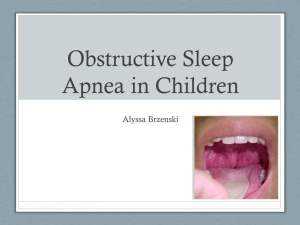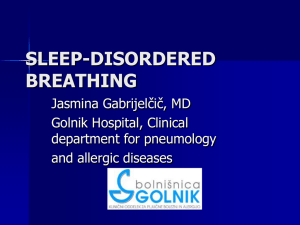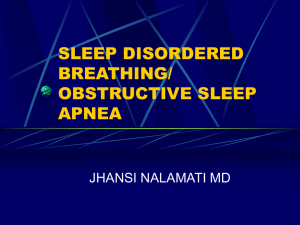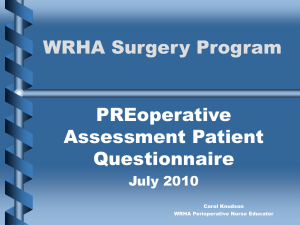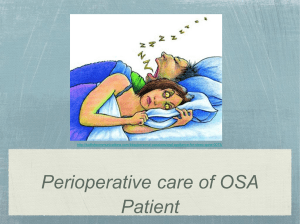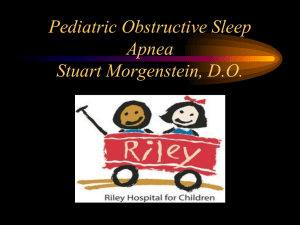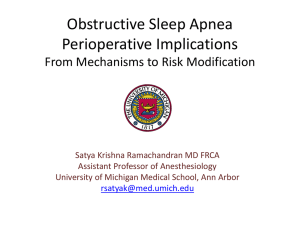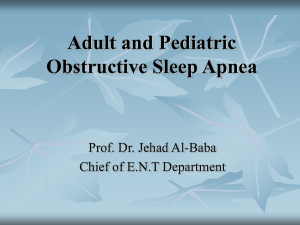Perioperative Management of OSA
advertisement
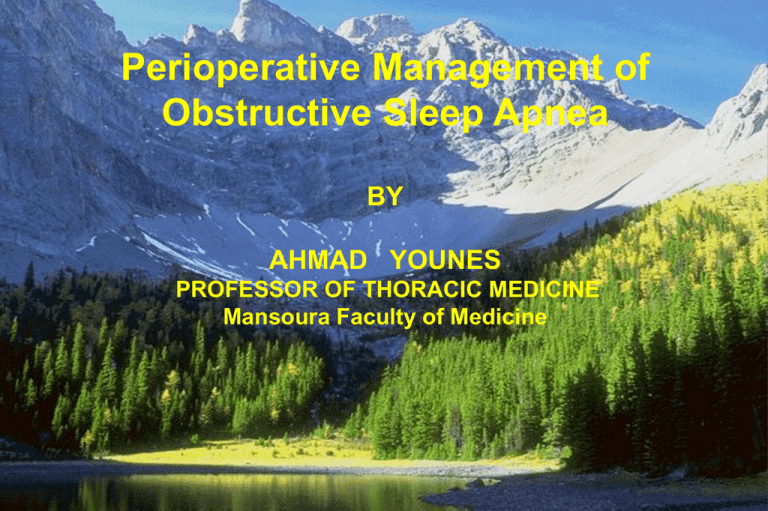
Perioperative Management of Obstructive Sleep Apnea BY AHMAD YOUNES PROFESSOR OF THORACIC MEDICINE Mansoura Faculty of Medicine SLEEP DISORDERED BREATHING • The standard parameters used to record sleep and wake are electroencephalography (EEG), electro-oculography (EOG), electromyography (EMG), airflow measurement, respiratory effort measurement, electrocardiography (ECG), oxygen saturation, snoring monitor, and sleep position evaluation. • All these parameters are recorded in polysomnography which is the gold standard for diagnosis of Sleep disordered breathing . Types of Sleep disordered breathing includes : 1-Obstructive sleep apnea syndrome in which inadequate ventilation occurs despite continued efforts to breath due to upper airway obstruction. 2- Central sleep apnea syndrome in which inadequate ventilation occurs resulting from absent or diminished respiratory effort. 3-Sleep hypoventilation syndrome in which > 10 mm Hg increase in PaCO2 during sleep in comparison with an awake supine value. Apnea: is defined as the drop in peak airflow by >90% of baseline for 10 seconds or longer and at least 90% of the event duration meet the amplitude reduction. • An obstructive apnea occurs when airflow is absent or nearly absent, but ventilatory effort persists. It is caused by complete, or near complete, upper airway obstruction A central apnea occurs when both airflow and ventilatory effort are absent. During a mixed apnea, there is an interval during which there is no respiratory effort (ie, central apnea pattern) and an interval during which there are obstructed respiratory efforts . Hypopnea • Hypopnea be scored when all of the following four criteria are met: • Airflow decreases at least 30 percent from baseline • There is diminished airflow lasting at least 10 seconds • at least 4 percent oxyhemoglobin desaturation . or • Airflow decreases at least 50 percent from baseline • There is diminished airflow lasting at least 10 seconds • 3 percent oxyhemoglobin desaturation or an arousal Apnea-hypopnea index (AHI) is the total number of apneas and hypopneas per hour of sleep. SLEEP DISORDERED BREATHING SYNDROMES 1- Obstructive sleep apnea syndrome (OSA) in adults is defined as either • More than 15 apneas, hypopneas, per hour of sleep ( AHI >15 events/hr) in an asymptomatic patient OR • More than 5 apneas, hypopneas, per hour of sleep (AHI >5 events per hour) in a patient with symptoms (eg, sleepiness, fatigue and inattention) or signs of disturbed sleep (snoring, restless sleep, and respiratory pauses). 2- Central sleep apnea syndrome (CSAS) can defined as: a. Study showing AHI > 5 events/hr. and b. Central AHI > 50% of the total AHI, and c. Central apneas or hypopneas >=5/hr., and d. Symptoms of either excessive sleepiness or disrupted sleep. 3- Sleep Hypoventilation Syndrome Score hypoventilation during sleep if there is a ≥10 mm Hg increase in PaCO2 during sleep in comparison with an awake supine value OSA is the most prevalent sleep disorder in the adult population. • OSA is more common than bronchial asthma in adults ,affecting approximately 4% of men and 2% of women. • The prevalence of OSA is higher in patients presenting for surgery than in the general population e.g. moderate or severe OSA is prevalent in at least 50% of patients subjected to bariatric surgery , and a significant proportion of OSA patients remain undiagnosed when they present for surgery. • The presence of OSA is known to increase the occurrence of comorbid conditions ( hypertension , ischemic heart disease , diabetes melitus and stroke ) and postoperative complications . • It is the opinion of the American Society of Anesthesiologists Task Force that the perioperative risk to patients increases in proportion to the severity of sleep apnea. OSA and postoperative complications • In a recent retrospective study of elective non-cardiac procedures, the occurrence of postoperative complications was observed in 44% of patients with OSA versus 28% in patients with no OSA. • Patients with OSA undergoing hip or knee replacement were at an increased risk of developing perioperative complications (24% versus 9%, respectively). • An increased risk of postoperative complications was also observed in OSA patients undergoing upper airway and cardiac procedures . • The most commonly observed complication was oxygen desaturation (17% in patients with OSA versus 8% with no OSA). OSA and postoperative complications • Proposed guidelines from the Adult OSA Task Force of the American Academy of Sleep Medicine suggest that : 1- Questions regarding OSA should be included in routine health screenings. 2- If OSA is suspected, a comprehensive sleep evaluation should be conducted. • Interestingly, it was observed that OSA patients undergoing surgery had higher AHI and oxygendesaturation index scores on the third postoperative night compared to the first postoperative night or preoperatively . Perioperative Management Plan • Anesthesiologists should work with surgeons to develop a protocol whereby patients in whom the possibility of OSA is suspected on clinical grounds are evaluated long enough before the day of surgery to allow preparation of a perioperative management plan. • This evaluation may be initiated in a preanesthesia clinic (if available) or by direct consultation from the operating surgeon to the anesthesiologist. • The perioperative management of patients with OSA begins with preoperative identification ,after which plans are made to tailor specific preoperative ,intraoperative and postoperative care. OSA symptoms OSA signs Screening for OSA prior to surgery • It is estimated that 82% of men and 92% of women with moderate-to-severe sleep apnea have not been diagnosed. • A substantial proportion of these patients present for surgery and may have an increased risk of perioperative complications. • The screening tools may assist in the diagnosis of OSA when associated with a high index of clinical suspicion. • Snoring is a prime symptom of OSA and is almost 100% sensitive, however it lacks specificity and has a low positive predictive value. Screening for OSA prior to surgery • A study screening preoperative patients using the Berlin Questionnaire determined that it had a sensitivity of 69% and a specificity of 56% in surgical patients. • Although validated in primary care settings, the Berlin Questionnaire is a complicated scoring system with a large number of questions. • The American Society of Anesthesiologists developed a tool in 2006 to help assist anesthesiologists in identifying patients with OSA. • It comprises a 14-item checklist categorized into history of airway obstruction during sleep , physical characteristics, and complaints of somnolence . American Society of Anesthesiologists Checklist High risk of OSA if 2 or more categories scored as positive. Low risk of OSA if 1 or no categories scored as positive Screening for OSA prior to surgery • The sensitivity of the American Society of Anesthesiologists checklist was 79% at AHI of > 15 and 87% at AHI > 30. • A significant step forward in the screening of patients for OSA was the development of a more concise and easy-to-use bedside screening tool abbreviated as the STOP Questionnaire • The sensitivity of the STOP questionnaire with AHI > 15 and > 30 as cut-offs were 74% and 80% respectively. • The specificity at similar AHI levels was 53% and 49% respectively. The STOP questionnaire Screening for OSA prior to surgery • When combined with BMI, age, neck circumference, and gender, the STOP Questionnaire had a high sensitivity, especially for patients with moderate to severe OSA. • This combined version is commonly referred to as the STOP-Bang Questionnaire . • The use of the STOP-Bang Questionnaire improved the sensitivity to 93%, and 100% at AHI cut-offs of >15 and >30 respectively, making it an ideal screening tool with a high sensitivity level. • The specificity of the STOP-Bang Questionnaire at similar AHI levels was 43% and 37% respectively. • The STOP-Bang scoring model. Screening for OSA prior to surgery • Various other screening modalities including the modified Mallampatti score of 3 or 4, or a waist circumference of > 105 cm, have been correlated well with an increased AHI . • With analyzing the accuracy of clinical screening methods in the diagnosis of OSA (26 different clinical prediction tests with 8 in the form of questionnaires, and 18 algorithms, regression models or neural networks ), STOP-Bang Questionnaire was described as a user-friendly and excellent method to predict severe OSA (AHI >30). • The linear scale and the simple acronym make the STOPBang Questionnaire practical and easy-to-use in the preoperative setting. • STOP-Bang is now widely adopted as a screening tool for OSA in primary care settings, preoperative clinics and sleep clinics. In the Mallampati maneuver, patients are instructed not to emit sounds but to open the mouth as wide as possible and protrude the tongue as far as possible. In the modified Mallampati, the patient is instructed to open the mouth as wide as possible without emitting sounds. Screening for OSA prior to surgery • Nocturnal oximetry may be a sensitive and specific tool to detect OSA in surgical patients. • There was a strong correlation between nocturnal oximetry and the AHI from polysomnography . • The oxygen desaturation index measured by nocturnal oximetry had a sensitivity of 75-95% and a specificity of 67-97% as compared to AHI. • The availability of various screening modalities and an increasing awareness of the occurrence of OSA may lead to more patients being diagnosed with this challenging condition. Nocturnal oximetry Screening for OSA prior to surgery • Preoperative preparation can include the use of home sleep tests e.g. Apnea Link as a diagnostic tool for OSA. • The diagnostic gold standard remains polysomnography carried out overnight in a sleep clinic, often times this is an expensive, time-consuming option. • There frequently is not enough time from the date of scheduled surgery to obtain necessary authorizations and appointments for a PSG, resulting in the need for alternative diagnostic methods. • For the anesthesiologist who first suspects sleep apnea in a preoperative clinic for surgery scheduled several days in the future, the patient’s surgery would have to be cancelled and rescheduled pending the PSG and appropriate treatment Apnea Link Screening for OSA prior to surgery • Pulse oximetry as a single metric of sleep apnea lacks the sensitivity and specificity of PSG and multi-channel home sleep testing . • If the goal is only to cipher out those with an AHI of 15 or 20 or more, pulse oximetry can be considered. • Centers for Medicare and Medicaid Services, 2009 reported that the final decision supporting equally effective testing utilizing PSG and home sleep tests, as measured by outcomes and patient compliance . • While patients with mild OSA may not require preoperative PAP therapy, patients with moderate and severe OSA who have been on PAP therapy should continue treatment in the preoperative period . • Patients who have been noncompliant with instructions for CPAP use prior to surgery and are in need of CPAP postsurgery, pose the highest risk of potential complications . Preoperative optimization of patients with known or suspected OS A • There are a substantial percentage of patients diagnosed with OSA who are often prescribed CPAP or BPAP devices. • The current use of CPAP or BiPAP should be noted with special care on compliance to therapy. • Patients should be advised to bring their CPAP devices to the hospital on the day of surgery for postoperative use. • A subset of patients may need reassessment preoperatively, especially patients with a known diagnosis of OSA but lost on followup, recent exacerbation of OSA symptoms, those who have undergone OSA-related airway surgery, or have been non-compliant with CPAP . • Experience suggests that restarting preoperative CPAP may be beneficial on non-compliant patients. • The American Society of Anesthesiologists task force on the management of OSA recommends that patients with moderate and severe OSA who have been on CPAP therapy should continue with CPAP in the postoperative period . Preoperative optimization of patients with known or suspected OSA • Precautions should be taken in anticipating the possibility of having a difficult airway • Most patients may be obese and appropriate care should be taken to prevent desaturation . • It is useful to employ short-acting anesthestic drugs, less soluble inhalational agents, titrate opioids, and minimize sedation . • In patients with anticipated difficult airways, awake extubation may have to be performed preferably in a 30° to 45° head-up position. • The routine perioperative care may be adequate for patients with mild OSA. If patients have any co-morbidities, they should be optimized. • Patients may benefit by the modifications of anesthetic technique such as avoidance of general anesthesia in favor of a central neuraxial or a peripheral nerve block. Preoperative optimization of patients with known or suspected OSA Intra-operative optimization of patients with known or suspected OSA Intra-operative optimization of patients with known or suspected OSA • Several issues can arise intraoperatively in the OSA patient, including difficult intubation, opioid-related respiratory depression, and excessive sedation; provides an overview of potential anesthetic concerns with the OSA patient . • Two important correlates of difficult intubation are a higher Mallampati score ≥ 3, neck circumference > 40 cm, or waist circumference > 105 cm ; same for both genders). Intra-operative optimization of patients with known or suspected OSA • Proper positioning should include supporting the obese patient behind the upper back and head to achieve an anatomical position where a horizontal plane between the sternal notch and the external auditory meatus is established. • In patients with OSA, the sitting posture decreases the frequency of airway obstruction compared to supine, and the benefits from upright positioning are enhanced in the obese patient. • Placing patients into a sitting position for preoxygenation and anesthetic induction should be considered. Intra-operative optimization of patients with known or suspected OSA • The obese patient has a reduced FRC, and tidal volume often falls below the closing capacity of the small airways, leading to atelectasis, increased intrapulmonary shunting, and impaired oxygenation. • FRC is further reduced after induction of anesthesia, when the weight of the anterior chest compresses the thorax. • At least three minutes of breathing 100% oxygen or five vital capacity breaths of 100% oxygen are essential. • For superficial procedures, one should consider the use of local anesthesia or peripheral nerve blocks, with or without moderate sedation. • If moderate sedation is used, ventilation should be continuously monitored by capnography or another automated method if feasible because of the increased risk of undetected airway obstruction in these patients. Intra-operative optimization of patients with known or suspected OSA • One should consider administering CPAP during sedation to patients previously treated with these modalities. • General anesthesia with a secure airway is preferable to deep sedation without a secure airway, particularly for procedures that may mechanically compromise the airway. • Spinal/epidural anaesthesia should be considered for peripheral procedures. • Full reversal of neuromuscular block should be verified before extubation. When possible, extubation and recovery should be carried out in the lateral, semi-upright, or other non-supine position. Intra-operative optimization of patients with known or suspected OSA Post-operative optimization of patients with known or suspected OSA • Postoperative concerns in the management of patients with OSA include: (1) analgesia, (2) oxygenation (3)patient positioning (4) monitoring. • Risk factors for respiratory depression include the systemic and neuraxial administration of opioids, administration of sedatives, site and invasiveness of surgical procedure, and severity of the sleep apnea. • • Postoperative residual curarization is common after administration of neuromuscular blocking agents. Suggested practices include verification of full neuromuscular blockade recovery, ensuring the patient is fully conscious prior to extubation, and placing the patient in a semi-upright recovery position. Anticipating possible difficult airways, use of short-acting anesthetic agents, opioid minimization, reversal prior to extubation, and extubation in a non-supine position. Post-operative optimization of patients with known or suspected OSA • Opioids suppress REM and slow wave sleep . • REM rebound contribute to haemodynamic instability , myocardial ischemia and infarction ,stroke ,mental confusion and wound breakdown. • Exacerbation of respiratory depression may occur on the third or fourth postoperative day as sleep patterns are reestablished and “REM rebound” occurs. Post-operative optimization of patients with known or suspected OSA • Supplemental oxygen should be administered continuously to all patients who are at increased perioperative risk from OSA until they are able to maintain their baseline oxygen saturation while breathing room air. • The Task Force cautions that supplemental oxygen may increase the duration of apneic episodes and may hinder detection of atelectasis, transient apnea, and hypoventilation by pulse oximetry. • CPAP or BiPAP, with or without supplemental oxygen, should be continuously administered when feasible to patients who were using these modalities preoperatively, unless contraindicated by the surgical procedure. Post-operative optimization of patients with known or suspected OSA • Compliance with CPAP or BiPAP may be improved if patients bring their own equipment to the hospital. • Intermittent pulse oximetry or continuous bedside oximetry without continuous observation does not provide the same level of safety. • If frequent or severe airway obstruction or hypoxemia occurs during postoperative monitoring, initiation of nasal CPAP or BiPAP should be considered. Management of patients scheduled for ambulatory surgery • Due consideration must be given to 1- The type of surgery, 2- Associated co-morbidities, 3-Patient’s age 4- Severity of OSA 5-The treatment status 6-Anticipated use of postoperative opioids 7-The type of anesthesia (local vs general vs nerve blocks with or without sedation) and 8- Home care . • The American Society of Anesthesiologists Advisory Guidelines on the Perioperative management of patients with OSA suggests that superficial surgeries or minor orthopedic surgery using local or regional techniques, and lithotripsy, may be done on an ambulatory basis. Consultant Opinions Regarding Procedures That May Be Performed Safely on an Outpatient Basis for Patients at Increased Perioperative Risk from OSA Management of patients scheduled for ambulatory surgery • Patients with regional anesthesia also have elevated AHI and oxygen desaturation. This may imply that OSA patients need to be treated with CPAP. • Regarding ambulatory surgery, short-acting anesthetic agents and non-invasive surgery typically makes this a safer option for patients with OSA. • Severe untreated or undiagnosed OSA requiring postoperative narcotics after ambulatory surgery may be unsafe. • The consultants indicated that monitoring of patients with OSA should continue for a median of 7 h after the last episode of hypoxemia while breathing room air in an unstimulating environment. Management of patients scheduled for ambulatory surgery • Patients may be discharged to home provided that there is no moderate or severe OSA, no recurrent adverse events in postanesthesia care unit (PACU) such as apnea or desaturation, and no requirement of postoperative opioid . • It is important to realize that ambulatory surgical facilities managing OSA patients should have transfer arrangements to an inpatient facility, and be equipped to handle the potential problems that may arise while dealing with OSA patients. Management of patients scheduled for hospital stay • The 2006 American Society of Anesthesiologists guidelines recommend that the postoperative destination should be based on risk factors and a weighted scoring system . • The patient’s risk is determined based on the severity of OSA, the type of surgery and anesthesia, and the need for postoperative opioids. • The final total risk score will be the guide for the anticipated requirement for postoperative monitoring of patients. The occurrence of recurrent respiratory events in PACU can be used as a reliable indicator to determine whether the known or suspected OSA patient requires continuous postoperative monitoring. • The PACU respiratory event is defined as either:1- An apnea for ≥ 10 s (1 episode needed for yes), 2-Bradypnea of < 8 breaths per minute (3 episodes needed for yes), 3- Pain-sedation mismatch, or 4-Desaturations to < 90% (3 episodes needed for yes) in one 30-minute time block. The event is considered significant when any of one of them occurs in two separate 30-minute time blocks . This will make it possible to identify the majority of OSA patients that require further monitoring. • It is highly likely that these patients may require CPAP therapy. • Patients with OSA have a more profound increase in AHI on postoperative night 3 and return to preoperative levels on night 7 . Sleep Spindles Special considerations for postoperative management Postoperative analgesia • OSA is one of the major risk factors contributing to the occurrence of respiratory depression . • The use of opioids can be a special concern in patients with OSA, as most opiates including morphine, meperidine, hydromorphone, and fentanyl cause a dose-dependent reduction of respiratory drive, respiratory rate, and tidal volume that in turn can lead to hypoventilation, hypoxemia, and hypercarbia . • Sedatives , anesthetics and analgesics may selectively compromise respiratory function in OSA patients. • The general recommendation is that opioids and other drugs with central respiratory and sedating effects should be avoided, if possible. It is imperative to minimize the use of opioids in diagnosed or suspected OSA patients. Postoperative analgesia • The use of morphine in OSA has been deleterious with reports of respiratory depression and even death. • There may be genetic factors that may play a role in having differing effects on opioid induced respiratory effects. • Oxygen desaturations were 12 to 14 times more likely to occur in OSA patients receiving oral or parenteral opioids as opposed to those receiving non-opioid analgesic agents . Alternative to opioid therapy • The use of multimodal analgesia may be more beneficial in patients with OSA in minimizing the opioid-related side effects and providing effective analgesia as well. • There are a plethora of medications that can be used, such as nonsteroidal anti-inflammatory drugs, acetaminophen, tramadol, ketamine, gabapentin, and pregabalin . • Caution should be advocated while using some of these drugs like gabapentin with the side effect of sedation. Dexmedetomidine has been particularly beneficial because of the opioid sparing effect and the lack of respiratory depression. Alternative to opioid therapy • • • • • The American Society of Anesthesiologists guidelines recommend regional anesthesia to reduce the possibility of negative adverse events associated with systemic opioids. The use of nonsteroidal anti-inflammatory analgesics is strongly recommended . The use of nerve blocks with or without catheters with local anesthetics obviates the need for systemic opioid analgesics. Caution should be exercised in using neuraxial opioids in patients with OSA as there are reports of postoperative respiratory arrest in a case series of three patients . Patients with OSA may be at an increased risk of perioperative complications with the use of strong opioids even after a regional anesthetic. Respiratory Arrest in the Hospital • Over 90% of inpatient arrests are brady-asystolic, with the vast majority of these involving known respiratory or cardiovascular insufficiency prior to loss of vital signs. • Approximately half of non-ICU arrests involve acute and unexpected respiratory insufficiency, most of which have an identifiable risk factor for apnea. • These risk factors include a decrease in level of consciousness combined with a process leading to mechanical obstruction. • Level of consciousness may be modified by medications (sedatives / narcotics), encephalopathy, anesthetics, or even sleep itself). Respiratory Arrest in the Hospital • Mechanical obstruction may be related to obesity, airway swelling / masses, or placement in the supine position. • The challenge is to identify patients at risk for inpatient apnea/ hypopnea with enough sensitivity to prevent arrests and enough specificity to avoid occupying monitored beds unnecessarily • The STOP-Bang questionnaire is applied in the preoperative clinic, with positive screens leading to multichannel home sleep testing. • Once a diagnosis of OSA is made, patients undergo a longer period of observation in the PACU followed by admission to a designated inpatient bed with capnometry, continuous pulse oximetry, and ECG monitoring. Evidence for using perioperative CPAP • CPAP exerts its beneficial effects by acting as a pneumatic splint and prevents the obstruction to airflow during sleep. • Postoperative CPAP reduces airway obstruction, reduces major postoperative complications and shortens the hospital stay. • The American Society of Anesthesiologists task force recommends that patients continue with their routine CPAP through the perioperative period. • The patients are better advised to get their own CPAP device to the hospital on the day of surgery. OSA and Malpractice • Adverse outcomes can occur due to intubation difficulties (due to increased oropharyngeal classification, decreased atlanto-occipital extension, thick neck and occasionally micrognathia and retrognathia) and extubation difficulties (due to loss of optimal airway management position, monitors off the patient, patients not fully awake, no oropharyngeal airway), and together constitute approximately 30% of the malpractice OSA cases. • The prototypical OSA malpractice case, constituting approximately 70% of the cases, is finding a postoperative patient dead in bed. • The clinical components of the prototypical OSA malpractice “dead in bed” case are: (1) Severe OSA (2) Morbid obesity (3) Patient in an isolated ward room, (4) Has no monitoring (5) Is receiving narcotics (6) Has a painful incision (7) Is off oxygen and (8) Is off his or her CPAP device. OSA and Malpractice • Primary care doctors, sleep doctors, surgeons and anesthesiologists must have ready access to all OSA - related information in OSA patients; it has been suggested that the best way to ensure this continuity of care is to issue medical alert bracelets to patients who have severe OSA. • Even though initial costs may rise due to the increase in time and equipment needed to screen and diagnose patients, ultimately, litigations will decrease due to improved patient care in the perioperative environment. • Custom made Wristbands for Patient Safety By providing hospital caregivers with a visual notification of risk by using a wristband, specific precautions can be taken to ensure the patient receives the best care possible. Conclusion • The combination of anesthesia and undiagnosed OSA can be potentially dangerous and places the patients at an increased risk of perioperative complications and postoperative morbidity. • Encouraging clinicians to be cognizant of patients with specific risk factors for OSA remains an important aspect of quality health care. • Screening of patients with the STOP-Bang Questionnaire will identify patients at risk of OSA. • Combining preoperative screening of OSA and identifying recurrent PACU respiratory events will allow risk stratification of diagnosed or suspected OSA patients for more focused postoperative care. Conclusion • Simplified questionnaires and a myriad of inexpensive, quick at home sleep tests have provided a necessary first step in arriving at a solid, evidence-based system for identifying patients with OSA prior to the operating room setting, which can only serve to diminish the potentially negative outcomes associated with surgery and OSA. • Postoperative management of patients with OSA should include close monitoring postoperatively . • Adequacy of postoperative respiratory function may be documented by observing patients in an unstimulated environment,preferably while they seem to be asleep, to establish that they are able to maintain their baseline oxygen saturation while breathing room air.
